In the relatively mild European climate, space cooling equipment is still a bit uncommon compared to e.g. the US, Japan or South Korea. Not surprisingly, the EU air conditioner market is dominated by companies originating from those countries, and –with time, increased income of Europeans, a sharp decrease in product price and more frequent heat waves– have succeeded in realising market growth not only in offices but also in the home.
While in 1990 less than 7 million room air conditioners (RACs) were installed, this number has increased to over 57 million in 2020. The estimate for 2030 is that over 100 million RACs will be installed, of which 70 million in households (35% of the European households having 1 RAC for space cooling).
In 2020, almost all sold RACs were reversible, meaning that in addition to cooling in the summer they can also provide heating during the winter.
Source: estimations from the Ecodesign Impact Accounting Overview Report 2024
Scope
The following table shows some examples of products in scope and out of scope in the Ecodesign Regulation:
| In Scope | Out of Scope |
|---|---|
|
|
Check the complete list in Ecodesign Regulation and the Energy Labelling Regulation
Ecodesign Requirement
Ecodesign requirements for minimum energy performance, maximum sound levels and product information apply to air conditioners and comfort fans sold in the EU. The requirements apply to air conditioners with a rated capacity smaller than or equal to 12 kW for cooling (or heating if there is no cooling function) and to comfort fans with an electric fan power input smaller than or equal to 125W. Non-electric appliances and air conditioners which do not use air as a heat transfer medium are excluded from the scope of this regulation.
Energy Label
Air conditioners come with an energy label showing their energy efficiency, which includes information on the energy rating of their cooling and heating functions and indications of their hourly or annual energy consumption and also their sound levels.
The European Product Registry for Energy Labelling (EPREL) offers more detailed information on models placed on the EU market. The database provides additional information such as sound power, efficiency in heating for 3 different climates, efficiency in cooling mode, annual electricity consumption, design load in heating and in cooling mode, sound power and refrigerant type.
| Understanding the Air Conditioner Energy Label | |
|---|---|
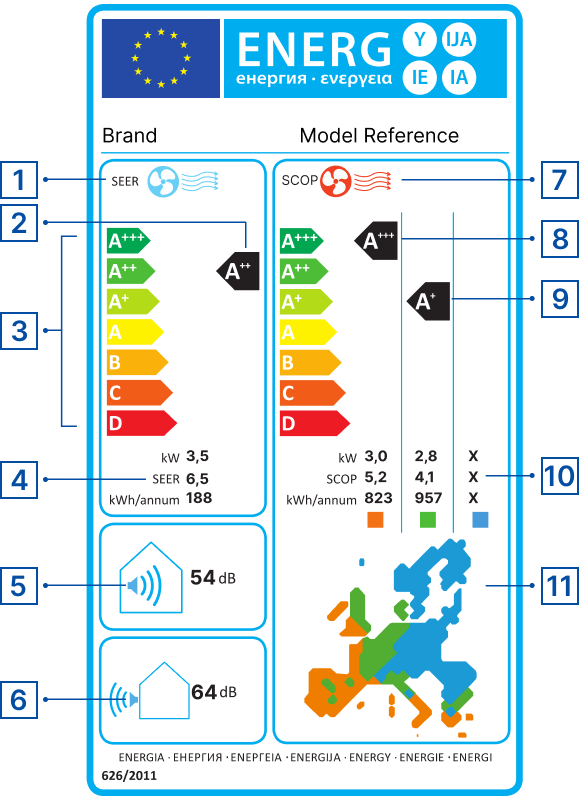 |
|
- To limit indoor temperature increase, prevent sunlight to enter your dwelling as much as possible, using blinds, shutters or window films
- Comfort fans (just as crosswinds) can make a good job at refreshing you while consuming much less energy than air conditioners
- Comfort fans can work in parallel with air conditioners and allow you to increase the thermostat and save energy
- Don’t air out while cooling
- When selecting an air conditioner a central air conditioning unit, be sure to choose one with the proper capacity and highest efficiency, don’t oversize it
- Do not place lamps or TV sets near your thermostat(which can be either a separate equipment on the wall, or a temperature sensor in the remote control). The thermostat senses heat from these appliances which can cause the air conditioner to run longer than necessary
- Increase the temperature set point as much as comfortable to save energy
- Cranking down the thermostat will lead to higher consumption, less comfortable operation because of more frequent start and stop of compressor and fan and higher component wearing
Highlights
These are estimated to have saved 11 TWh and nearly 5 million tons of CO2 emissions in 2020. An air conditioner manufactured in accordance with these requirements is estimated to save €340 on energy bills during its lifetime.
Facts & Figures
This graphic shows the estimated sales, stock, energy consumption (primary, electric or fuel), greenhouse gas emissions, consumer expenses and business revenues for years 2010 and 2030. The estimated values inside the graph bars are those from the EIA ECO-scenario, they include the effects of Ecodesign and Energy Labelling measures.
The difference with the business as usual (BAU) scenario without these estimated measures is shown next to the graph bar. These figures indicate the estimated savings obtained due to the measures.
Product: Room Air Conditioner Measures: Ecodesign Commission regulation 206/2012, Energy labelling Commission regulation 626/2011, Energy labelling Commission directive 2002/31 |
|---|
| The striped lines in the charts show the 'Effect of the Regulations' |
SALES (x1000 units) 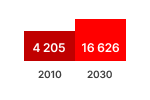 | STOCK (x1000 units) 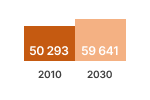 | Electricity (TWh/a) 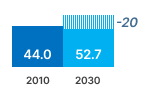 |
GHG-EMISSION 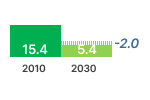 | CONSUMER EXPENSES 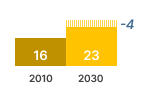 | REVENUES 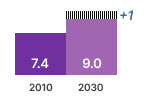 |
Source: estimations from the Ecodesign Impact Accounting Overview Report 2023
In 2020, 57 million room air conditioners (RACs) were in use in the EU27, of which 86% was fixed installed and 14% was portable. Of the fixed RACs, 47% were also used for heating.
These RACs provided 78 TWh of cooling (9% of the EU27 total cooling demand) and 112 TWh of heating (7% of the EU27 total heating demand).
To do this, they used 15 TWh of electricity for cooling and 29 TWh for heating. The total of 44 TWh is 1.8% of the total EU27 electricity consumption in 2020 (2384 TWh).
RACs are air-to-air heat pumps which transport heat rather than generating it themselves. They use the energy contained in the air, enabling them to remove or provide more heat in output than electricity in input, meaning efficiency (output divided by input) is larger than 100%.
Without measures, the average cooling efficiency of sold RACs would have been 350% in 2020, increased by the regulations to 536% (SEER 5.4, +53% relative), projected to further increase to 590% in 2030 (SEER 5.9).
Without measures, the average heating efficiency of sold RACs would have been 295% in 2020, increased by the regulations to 407% (SCOP 4.1, +38% relative), projected to further increase to 423% in 2030 (SCOP 4.2).
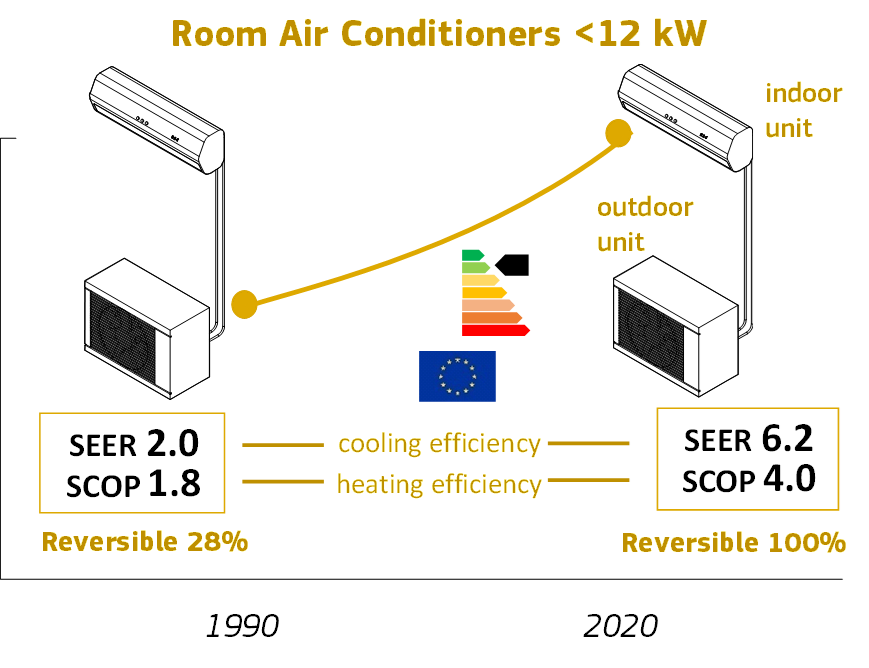
The regulations saved 22 TWh of electricity in 2020 (-33%), projected to increase to 31 TWh by 2030 (-27%).
The 2020 savings are 0.9% of the total EU27 electricity consumption (2384 TWh in 2020), and close to the consumption of Slovakia.
Due to Ecodesign and Energy Labelling, EU27 users saved € 1.7 billion on RACs in 2020 (-8%), projected to increase to € 5.6 billion in 2030 (-14%).
In 2030, annual household RAC expenses are expected to decrease from € 138 to € 120.
Expected Savings
Due to the Ecodesign and Labelling measures the average cooling efficiency of RACs increases by a factor 1.46 and the heating efficiency by a factor 1.27 over the 2010- 2030 period. These improved products have higher acquisition costs (+1.8 billion euros in 2030) but lead to savings on energy costs (€ -7.4 bn in 2030), for net consumer expense savings of € 5.6 bn (fixed euros 2020 incl. VAT for residential users). Around 7% of these savings is due to heat load reduction by Ventilation Units.
The 2030 expense savings per household are € 18 per year, but only 35% of households is projected to have a RAC in 2030. The expense savings for households having a RAC is thus € 50 per year.
Consumer Expenditure Saving due to Ecodesign Measures on Room Air Conditioners: Additional Acquisition Costs and Savings on Energy Costs
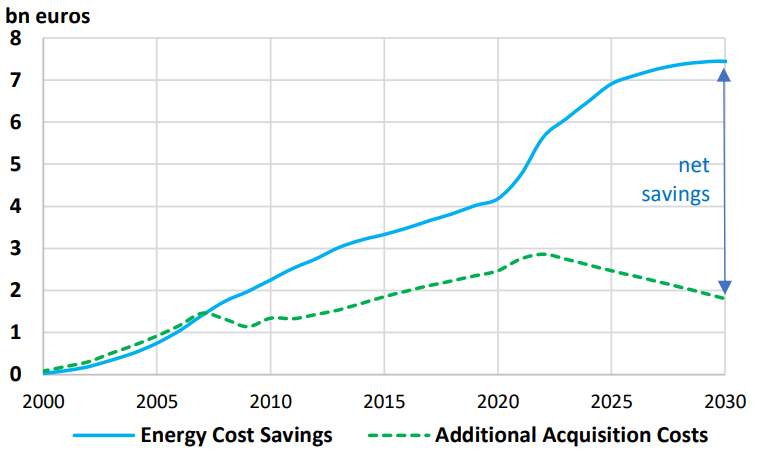
Electricity consumption
Despite the large numbers, the electricity use of RACs in cooling mode (12 TWh in 2020) is modest compared to the 151 TWh consumed in cooling mode by the 8.8 million larger, mostly centralised, air conditioning and chiller systems in commercial buildings that are subject to a separate Ecodesign regulation.
The electricity use of RACs in heating mode is 29 TWh/a in 2020 and thus higher than the consumption in cooling mode. This is mainly due to the average annual demand for heating output per unit (5000 kWh heat/a) being larger than the demand for cooling output (1400 TWh cool/a). In addition, efficiencies are higher in cooling mode than in heating mode. The measures lead to savings on both functions.
Source: estimations from the Ecodesign Impact Accounting Overview Report 2024

Suppliers
Suppliers shall ensure that:
(a) printed label is provided for each air conditioner respecting energy efficiency classes as set out in Annex II. The label shall comply with the format and content of information as set out in Annex III. For air conditioners, except single and double duct air conditioners, a printed label must be provided, at least in the packaging of the outdoor unit, for at least one combination of indoor and outdoor units at capacity ratio 1. For other combinations, the information can be alternatively provided on a free access web site;
(b) a product fiche, as set out in Annex IV, is made available. For air conditioners, except single and double duct air conditioners, a product fiche must be provided at least in the packaging of the out door unit, for at least one combination of indoor and outdoor units at capacity ratio 1. For other combinations, the information can be alternatively provided on a free access web site;
(c) technical documentation as set out in Annex V is made available electronically on request to the authorities of the Member States and to the Commission;
(d) any advertisement for a specific model of an air conditioner shall contain the energy efficiency class, if the advertisement discloses energy-related or price information. Where more than one efficiency class is possible, the supplier or the manufacturer, as appropriate, shall declare the energy efficiency class for heating at least in ‘Average’ heating season. Information in the cases where end-users cannot be expected to see the product displayed is to be provided as set out in Annex VI;
(e) any technical promotional material concerning a specific model of an air conditioner which describes its specific technical parameters shall include the energy efficiency class of that model as set out Annex II;
(f) instructions for use are made available;
(g) single ducts shall be named ‘local air conditioners’ in packaging, product documentation and in any advertisement material, whether electronic or in paper.
(h) an electronic label in the format and containing the information set out in Annex III is made available to dealers for each air conditioner model placed on the market from 1 January 2015 with a new model identifier, respecting energy efficiency classes set out in Annex II. It may also be made available to dealers for other air conditioner models.
(i) an electronic product fiche as set out in Annex IV is made available to dealers for each air conditioner model placed on the market from 1 January 2015 with a new model identifier. It may also be made available to dealers for other air conditioner models.

Dealers
Dealers shall ensure that:
(a) air conditioners, at the point of sale, bear the label provided by suppliers in accordance with Article 3(1) on the outside of the front or top of the appliance, in such a way as to be clearly visible;
(b) air conditioners offered for sale, hire or hire purchase where the end-user cannot be expected to see the product displayed, are marketed with the information provided by suppliers in accordance with Annexes IV and VI. Where the offer is made through the internet and an electronic label and an electronic product fiche have been made available in accordance with Article 3(1)(h) and 3(1)(i) the provisions of Annex IX shall apply instead;
(c) any advertisement for a specific model of air conditioner contains a reference to the energy efficiency class, if the advertisement discloses energy-related or price information. Where more than one efficiency class is possible, the supplier/manufacturer will declare the energy efficiency class at least in ‘Average’ season zone;
(d) any technical promotional material concerning a specific model which describes the technical parameters of an air conditioner includes a reference to the energy efficiency class(es) of the model and the instructions for use provided by the supplier. Where more than one efficiency class is possible, the supplier/manufacturer will declare the energy efficiency class at least in ‘Average’ season zone;
(e) single ducts shall be named ‘local air conditioners’ in packaging, product documentation and in any promotional or advertisement material, whether electronic or in paper.

Policy
Ongoing legislative work
Please check the ongoing initiatives on the Have your say portal.
Regulation (EU) 206/2012 of 6 March 2012 implementing Directive 2009/125/EC of the European Parliament and of the Council with regard to Ecodesign requirements for air conditioners and comfort fans Text with EEA relevance. More info on Delegated Act.
Regulation (EU) 626/2011 of 4 May 2011 supplementing Directive 2010/30/EU of the European Parliament and of the Council with regard to Energy Labelling of air conditioners.
Disclaimer: please pay attention to possible updates/changes as indicated in the Official Journal (green dot)

